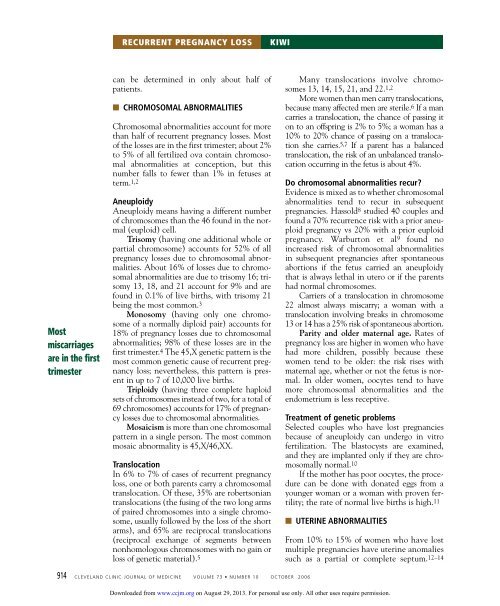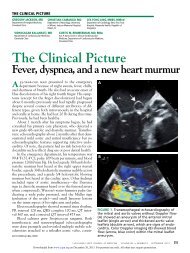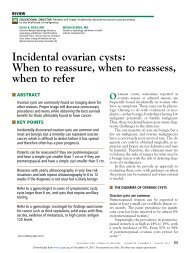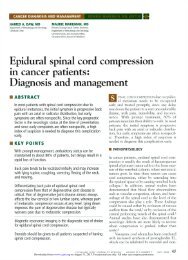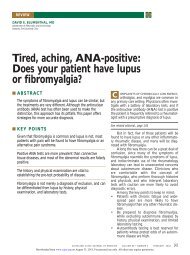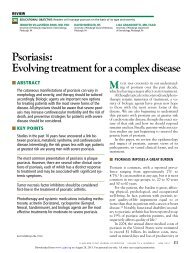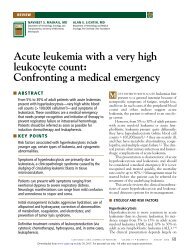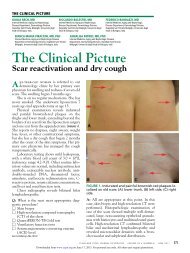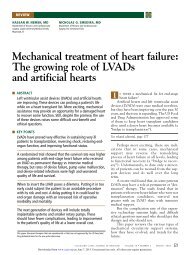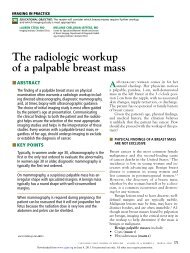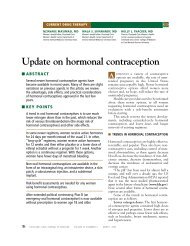Recurrent pregnancy loss: Evaluation and discussion of the causes ...
Recurrent pregnancy loss: Evaluation and discussion of the causes ...
Recurrent pregnancy loss: Evaluation and discussion of the causes ...
Create successful ePaper yourself
Turn your PDF publications into a flip-book with our unique Google optimized e-Paper software.
RECURRENT PREGNANCY LOSS<br />
KIWI<br />
Most<br />
miscarriages<br />
are in <strong>the</strong> first<br />
trimester<br />
can be determined in only about half <strong>of</strong><br />
patients.<br />
■ CHROMOSOMAL ABNORMALITIES<br />
Chromosomal abnormalities account for more<br />
than half <strong>of</strong> recurrent <strong>pregnancy</strong> <strong>loss</strong>es. Most<br />
<strong>of</strong> <strong>the</strong> <strong>loss</strong>es are in <strong>the</strong> first trimester; about 2%<br />
to 5% <strong>of</strong> all fertilized ova contain chromosomal<br />
abnormalities at conception, but this<br />
number falls to fewer than 1% in fetuses at<br />
term. 1,2<br />
Aneuploidy<br />
Aneuploidy means having a different number<br />
<strong>of</strong> chromosomes than <strong>the</strong> 46 found in <strong>the</strong> normal<br />
(euploid) cell.<br />
Trisomy (having one additional whole or<br />
partial chromosome) accounts for 52% <strong>of</strong> all<br />
<strong>pregnancy</strong> <strong>loss</strong>es due to chromosomal abnormalities.<br />
About 16% <strong>of</strong> <strong>loss</strong>es due to chromosomal<br />
abnormalities are due to trisomy 16; trisomy<br />
13, 18, <strong>and</strong> 21 account for 9% <strong>and</strong> are<br />
found in 0.1% <strong>of</strong> live births, with trisomy 21<br />
being <strong>the</strong> most common. 3<br />
Monosomy (having only one chromosome<br />
<strong>of</strong> a normally diploid pair) accounts for<br />
18% <strong>of</strong> <strong>pregnancy</strong> <strong>loss</strong>es due to chromosomal<br />
abnormalities; 98% <strong>of</strong> <strong>the</strong>se <strong>loss</strong>es are in <strong>the</strong><br />
first trimester. 4 The 45,X genetic pattern is <strong>the</strong><br />
most common genetic cause <strong>of</strong> recurrent <strong>pregnancy</strong><br />
<strong>loss</strong>; never<strong>the</strong>less, this pattern is present<br />
in up to 7 <strong>of</strong> 10,000 live births.<br />
Triploidy (having three complete haploid<br />
sets <strong>of</strong> chromosomes instead <strong>of</strong> two, for a total <strong>of</strong><br />
69 chromosomes) accounts for 17% <strong>of</strong> <strong>pregnancy</strong><br />
<strong>loss</strong>es due to chromosomal abnormalities.<br />
Mosaicism is more than one chromosomal<br />
pattern in a single person. The most common<br />
mosaic abnormality is 45,X/46,XX.<br />
Translocation<br />
In 6% to 7% <strong>of</strong> cases <strong>of</strong> recurrent <strong>pregnancy</strong><br />
<strong>loss</strong>, one or both parents carry a chromosomal<br />
translocation. Of <strong>the</strong>se, 35% are robertsonian<br />
translocations (<strong>the</strong> fusing <strong>of</strong> <strong>the</strong> two long arms<br />
<strong>of</strong> paired chromosomes into a single chromosome,<br />
usually followed by <strong>the</strong> <strong>loss</strong> <strong>of</strong> <strong>the</strong> short<br />
arms), <strong>and</strong> 65% are reciprocal translocations<br />
(reciprocal exchange <strong>of</strong> segments between<br />
nonhomologous chromosomes with no gain or<br />
<strong>loss</strong> <strong>of</strong> genetic material). 5<br />
Many translocations involve chromosomes<br />
13, 14, 15, 21, <strong>and</strong> 22. 1,2<br />
More women than men carry translocations,<br />
because many affected men are sterile. 6 If a man<br />
carries a translocation, <strong>the</strong> chance <strong>of</strong> passing it<br />
on to an <strong>of</strong>fspring is 2% to 5%; a woman has a<br />
10% to 20% chance <strong>of</strong> passing on a translocation<br />
she carries. 5,7 If a parent has a balanced<br />
translocation, <strong>the</strong> risk <strong>of</strong> an unbalanced translocation<br />
occurring in <strong>the</strong> fetus is about 4%.<br />
Do chromosomal abnormalities recur?<br />
Evidence is mixed as to whe<strong>the</strong>r chromosomal<br />
abnormalities tend to recur in subsequent<br />
pregnancies. Hassold 8 studied 40 couples <strong>and</strong><br />
found a 70% recurrence risk with a prior aneuploid<br />
<strong>pregnancy</strong> vs 20% with a prior euploid<br />
<strong>pregnancy</strong>. Warburton et al 9 found no<br />
increased risk <strong>of</strong> chromosomal abnormalities<br />
in subsequent pregnancies after spontaneous<br />
abortions if <strong>the</strong> fetus carried an aneuploidy<br />
that is always lethal in utero or if <strong>the</strong> parents<br />
had normal chromosomes.<br />
Carriers <strong>of</strong> a translocation in chromosome<br />
22 almost always miscarry; a woman with a<br />
translocation involving breaks in chromosome<br />
13 or 14 has a 25% risk <strong>of</strong> spontaneous abortion.<br />
Parity <strong>and</strong> older maternal age. Rates <strong>of</strong><br />
<strong>pregnancy</strong> <strong>loss</strong> are higher in women who have<br />
had more children, possibly because <strong>the</strong>se<br />
women tend to be older: <strong>the</strong> risk rises with<br />
maternal age, whe<strong>the</strong>r or not <strong>the</strong> fetus is normal.<br />
In older women, oocytes tend to have<br />
more chromosomal abnormalities <strong>and</strong> <strong>the</strong><br />
endometrium is less receptive.<br />
Treatment <strong>of</strong> genetic problems<br />
Selected couples who have lost pregnancies<br />
because <strong>of</strong> aneuploidy can undergo in vitro<br />
fertilization. The blastocysts are examined,<br />
<strong>and</strong> <strong>the</strong>y are implanted only if <strong>the</strong>y are chromosomally<br />
normal. 10<br />
If <strong>the</strong> mo<strong>the</strong>r has poor oocytes, <strong>the</strong> procedure<br />
can be done with donated eggs from a<br />
younger woman or a woman with proven fertility;<br />
<strong>the</strong> rate <strong>of</strong> normal live births is high. 11<br />
■ UTERINE ABNORMALITIES<br />
From 10% to 15% <strong>of</strong> women who have lost<br />
multiple pregnancies have uterine anomalies<br />
such as a partial or complete septum. 12–14<br />
914 CLEVELAND CLINIC JOURNAL OF MEDICINE VOLUME 73 • NUMBER 10 OCTOBER 2006<br />
Downloaded from www.ccjm.org on August 29, 2013. For personal use only. All o<strong>the</strong>r uses require permission.


